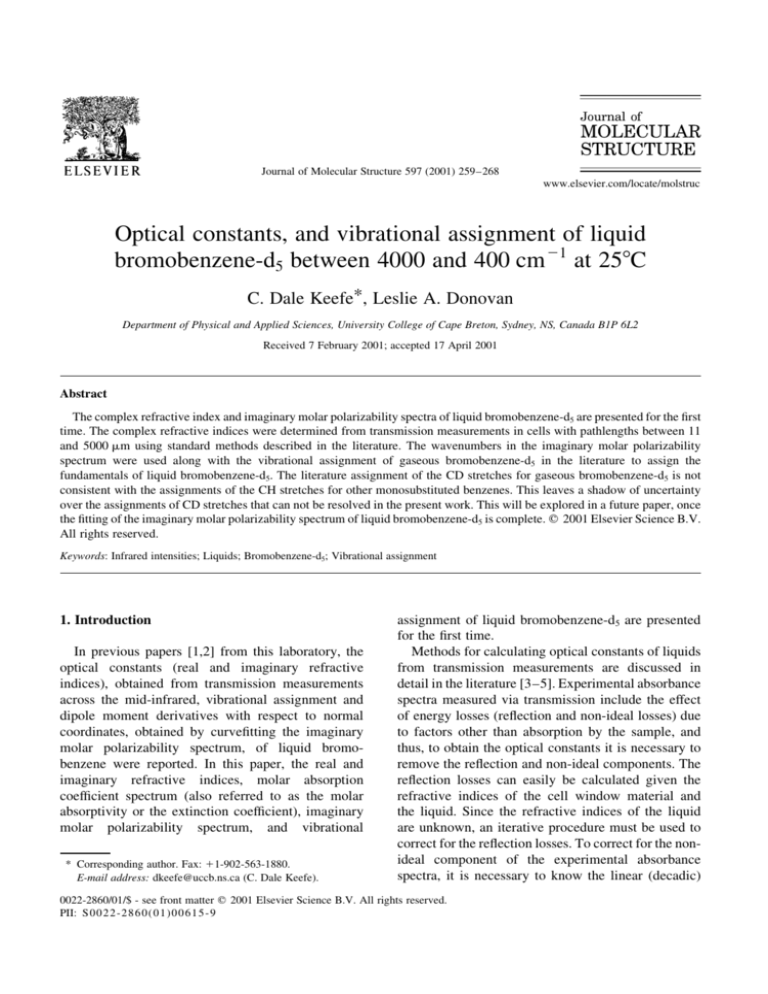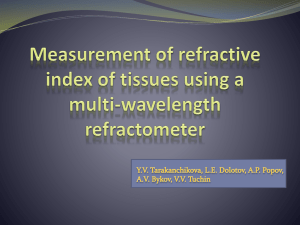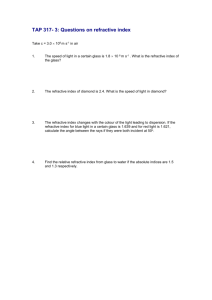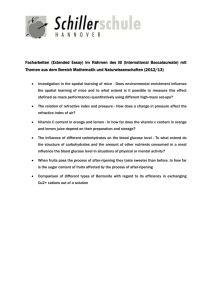
Journal of Molecular Structure 597 (2001) 259±268
www.elsevier.com/locate/molstruc
Optical constants, and vibrational assignment of liquid
bromobenzene-d5 between 4000 and 400 cm 21 at 258C
C. Dale Keefe*, Leslie A. Donovan
Department of Physical and Applied Sciences, University College of Cape Breton, Sydney, NS, Canada B1P 6L2
Received 7 February 2001; accepted 17 April 2001
Abstract
The complex refractive index and imaginary molar polarizability spectra of liquid bromobenzene-d5 are presented for the ®rst
time. The complex refractive indices were determined from transmission measurements in cells with pathlengths between 11
and 5000 mm using standard methods described in the literature. The wavenumbers in the imaginary molar polarizability
spectrum were used along with the vibrational assignment of gaseous bromobenzene-d5 in the literature to assign the
fundamentals of liquid bromobenzene-d5. The literature assignment of the CD stretches for gaseous bromobenzene-d5 is not
consistent with the assignments of the CH stretches for other monosubstituted benzenes. This leaves a shadow of uncertainty
over the assignments of CD stretches that can not be resolved in the present work. This will be explored in a future paper, once
the ®tting of the imaginary molar polarizability spectrum of liquid bromobenzene-d5 is complete. q 2001 Elsevier Science B.V.
All rights reserved.
Keywords: Infrared intensities; Liquids; Bromobenzene-d5; Vibrational assignment
1. Introduction
In previous papers [1,2] from this laboratory, the
optical constants (real and imaginary refractive
indices), obtained from transmission measurements
across the mid-infrared, vibrational assignment and
dipole moment derivatives with respect to normal
coordinates, obtained by curve®tting the imaginary
molar polarizability spectrum, of liquid bromobenzene were reported. In this paper, the real and
imaginary refractive indices, molar absorption
coef®cient spectrum (also referred to as the molar
absorptivity or the extinction coef®cient), imaginary
molar polarizability spectrum, and vibrational
* Corresponding author. Fax: 11-902-563-1880.
E-mail address: dkeefe@uccb.ns.ca (C. Dale Keefe).
assignment of liquid bromobenzene-d5 are presented
for the ®rst time.
Methods for calculating optical constants of liquids
from transmission measurements are discussed in
detail in the literature [3±5]. Experimental absorbance
spectra measured via transmission include the effect
of energy losses (re¯ection and non-ideal losses) due
to factors other than absorption by the sample, and
thus, to obtain the optical constants it is necessary to
remove the re¯ection and non-ideal components. The
re¯ection losses can easily be calculated given the
refractive indices of the cell window material and
the liquid. Since the refractive indices of the liquid
are unknown, an iterative procedure must be used to
correct for the re¯ection losses. To correct for the nonideal component of the experimental absorbance
spectra, it is necessary to know the linear (decadic)
0022-2860/01/$ - see front matter q 2001 Elsevier Science B.V. All rights reserved.
PII: S 0022-286 0(01)00615-9
260
C. Dale Keefe, Leslie A. Donovan / Journal of Molecular Structure 597 (2001) 259±268
Table 1
Computer programs used to perform calculations in this work
Program a
Based on
Description
anchorpt
anchorpt [1]
expabs2k
rnj46a [3,11]
irtyrue [8]
pathlen
rnj22a [1]
kktrans
n®t
dequant
kktrans [18]
n®t b
dequant [16]
Calculates the linear
absorption coef®cients
^ n~ from an
Calculates n
experimental absorbance
spectrum
Calibrates transmission cell
Calculates pathlength of cell
from fringe pattern
Performs KK transformation
Fits visible refractive indices
Calculates derived quantities
^ n~
from n
a
irytrue was written in FORTRAN and requires a minimum of
a 286 computer with a 287 numeric co-processor. All other
programs were written in C11 and require a minimum of a
Pentium computer running at least Windows 95 or Windows NT
4.0. The programs, except irytrue, can be obtained from CDK's
website: http://faculty.uccb.ns.ca/~dkeefe/programs.
b
Written in FORTRAN by J. Bertie's group.
absorption coef®cient, K(n~ ), at wavenumbers where
the absorption is weak. These wavenumbers are
referred to as the anchor points.
Program anchorpt 1 is used to determine the K(n~ )
values from transmission spectra measured in cells
with pathlengths chosen so that baseline absorption
is signi®cant, usually 2±10 times the pathlength
normally used to measure the region except where
very long pathlengths are required to measure the
absorbances accurately. Once the anchor points are
known, the optical constants of the liquids are determined from the experimental absorbance spectra via
program expabs2k (see Table 1).
Due to large variations in absorption across the
mid-infrared, which requires greatly different pathlengths to measure the absorbance accurately, the
spectrum was broken up into smaller regions of
similar absorption, and the imaginary refractive
indices, k(n~ ), were determined separately for each
region from spectra measured in cells with appropriate pathlengths. These k spectra were then averaged
and the average spectra for each region were merged
to give a complete k spectrum across the mid-infrared.
1
The programs used for the calculations in this paper are listed in
Table 1.
The real refractive index spectrum, n(n~ ), was obtained
by Kramers±Kronig (KK) transformation of k(n~ )
along with nel, the contribution of the electronic
transitions to the infrared real refractive index [6].
Equations given in Ref. [7] allow other properties
of the liquid, including the molar (decadic) absorption
coef®cient spectrum, Em(n~ ), the complex dielectric
constant spectrum, e^ (n~ ), and the chemically more
important imaginary molar polarizability spectrum,
a^ m(n~ ), to be calculated from the optical constants.
The imaginary molar polarizability is the quantity of
choice for studying absolute infrared absorption on a
molecular level [4,7].
2. Experimental
Bromobenzene-d5 labeled 99.5% atom D was
obtained from Aldrich. The bromobenzene-d5 was
used as obtained, except samples were kept over
molecular sieve to ensure that they were dry. GC-IR
and GC-MS analysis showed that impurities were
below the 0.01% level other than the expected mixture
of 79Br and 81Br isotopomers and the 6% 13C isotopomers.
All experimental absorbance spectra were
measured using a Nicolet Impact 410 FT-IR with a
mid-infrared Evergloe 2 source, a Ge-on-KBr beamsplitter, and a DGTS detector. The instrument has
a 9 mm aperture. One level of zero-®lling and
Happ±Genzel apodization were applied before
Fourier transformation.
Experimental absorbance spectra of bromobenzene-d5, and the calibration standards [8] benzene,
toluene and dichloromethane were measured in both
®xed-pathlength (FP) and variable-pathlength (VP)
cells, some of which had KBr windows and some of
which had CaF2 windows. Both background and
sample interferograms were collected at a nominal
resolution of 1 cm 21. In each case, 512 interferograms
were averaged before Fourier transformation. A new
single beam background spectrum was measured before
each single beam sample spectrum was recorded.
Spectra of benzene and toluene were measured in
order to determine whether the current experimental
measurements were consistent with accepted
2
e trademark of the Nicolet Instrument Corporation.
C. Dale Keefe, Leslie A. Donovan / Journal of Molecular Structure 597 (2001) 259±268
261
Table 2
Linear absorption coef®cients for liquid bromobenzene-d5 at 258C
n~
cm21
n
Pathlengths (mm)
# of spectra
K
n~
cm21
95% CL (cm 21) a
Uncertainty in k
n~
3868.6
3766.2
3459.7
3180.0
2992.4
2753.4
2473.7
2111.2
2058.6
1933.8
1800.7
1757.4
1620.4
1582.3
1491.1
1447.3
1376.4
1296.4
1240.1
1116.6
1087.2
975.3
911.3
708.2
627.2
577.1
480.7
434.4
1.5360
1.5365
1.5360
1.5361
1.5357
1.5356
1.5346
1.5346
1.5342
1.5331
1.5317
1.5312
1.5255
1.5217
1.5372
1.5285
1.5159
1.5496
1.5384
1.5266
1.5214
1.5479
1.5381
1.5200
1.5317
1.4971
1.5504
1.5222
3.5±5
5
5
3±5
3±5
5
3±5
3.5±5
4.5±5
4±5
3.5±5
3.5±5
1.2±1.5
0.5±1.2
1.2±1.5
2±3
0.5±1.5
0.2±0.5
1.5±2
1.5±3
1.5±3
0.2±0.5
0.5±1.5
0.5±1.5
0.2±0.5
0.2±0.5
0.5±1.5
0.5±1.5
38
12
12
53
53
12
53
45
24
35
45
45
23
23
23
29
35
24
18
40
40
24
24
24
24
24
20
20
0.7317
0.6541
0.3621
0.8582
1.0786
0.4296
0.9113
0.8411
0.4968
0.6431
0.6958
0.6919
5.6330
7.0225
5.6398
4.1523
11.1103
20.7769
2.7682
2.1801
4.7855
14.1065
4.7579
5.4924
36.2101
16.6194
5.1802
7.6393
0.0062
0.0078
0.0064
0.0295
0.0219
0.0028
0.0176
0.0157
0.0159
0.0166
0.0137
0.0138
0.0800
0.2003
0.0630
0.2022
0.1320
0.2278
0.0790
0.1039
0.1428
0.2305
0.2938
0.3264
0.4090
0.5318
0.6097
0.5702
2.9 £ 10 27
2.4 £ 10 27
3.4 £ 10 27
1.7 £ 10 26
1.3 £ 10 26
1.8 £ 10 27
1.3 £ 10 26
1.4 £ 10 26
1.4 £ 10 26
1.6 £ 10 26
1.4 £ 10 26
1.4 £ 10 26
9.0 £ 10 26
2.3 £ 10 25
7.7 £ 10 26
2.6 £ 10 25
1.8 £ 10 25
3.2 £ 10 25
1.2 £ 10 25
1.7 £ 10 25
2.4 £ 10 25
4.3 £ 10 25
5.9 £ 10 25
8.4 £ 10 25
1.2 £ 10 24
1.7 £ 10 24
2.6 £ 10 24
2.4 £ 10 24
a
CL indicates con®dence limits.
standards [8,9]. These benzene and toluene spectra
were analyzed by irytrue [8±10] to compare the
experimental spectra with the standards; no
systematic differences were obvious and variations
were within the reproducibility of the accepted
standards [8,9] (1±3%).
The experimental absorbance spectra of the empty
VP cells did not show a fringe pattern; these were
calibrated with benzene and dichloromethane. The
cell constants were determined with irytrue from
the experimental absorbance spectra of benzene and
dichloromethane in the VP cell with a number of
pathlengths less than 1400 mm. The difference
between the cell micrometer and the cell constant
was constant to within the 1±3% accuracy of
irytrue. Very few bands of the calibration standards
are suitable for calibration of pathlengths larger than
1400 mm, and calibration with the use of irytrue
would not be reliable. Therefore, the pathlengths of
VP cells larger than 1400 mm were found by assuming
that the calibration of the cell micrometer below
1400 mm was valid for these pathlengths.
For FP cells with a fringe pattern, pathlengths were
determined from experimental absorbance spectra of
the empty cell with the use of program pathlen (see
Table 1). Several of the thicker FP cells did not give a
fringe pattern and were calibrated with benzene as
described above for the VP cells.
3. Results
3.1. Imaginary refractive indices
The linear absorption coef®cients, K
n~ ; at the
anchor points used to correct the non-ideal
262
C. Dale Keefe, Leslie A. Donovan / Journal of Molecular Structure 597 (2001) 259±268
Table 3
Pathlengths, high-wavenumber refractive indices, and numbers of spectra processed for each region of bromobenzene-d5
Wavenumber limits (cm 21)
Pathlengths (mm)
n1 a
Number of spectra processed
4000±3340
3465±2457
2480±2110
2220±1870
1940±1796
1810±1755
1760±1616
1622±1580
1585±1485
1492±1410
1450±1365
1377±1295
1300±1235
1250±1066
1092±975
980±660
710±620
630±570
580±400
1500±2500
500
50±115
1200±5000
500±1500
3000±5000
500
115±200
11±15
500±1500
115±200
11
115±200
500±1500
11
15±50
11±15
15±50
11
1.5368
1.5359
1.5324
1.5363
1.5325
1.5317
1.5296
1.5254
1.5224
1.5359
1.5239
1.5162
1.5239
1.5403
1.5164
1.5521
1.5015
1.5396
1.5030
33
7
30
96
32
43
12
25
14
31
27
9
25
19
9
36
14
36
9
a
The values in this column are the real refractive indices at the highest wavenumber in each region. See text for a description of how they
were determined.
components of the baseline are listed in Table 2. To
calculate the linear absorption coef®cients, program
anchorpt requires an approximate value of the real
refractive index at each anchor point. These real
refractive indices were calculated from the imaginary
refractive index spectrum obtained without baseline
correction from an experimental absorbance spectrum
measured in an 11 mm cell, with n8000 1:5367 (the
value for C6H5Br minus 0.0005, vide infra). Also
listed in Table 2 for each anchor point are the pathlengths and number of spectra used to determine the
linear absorption coef®cient, as well as the 95%
con®dence limit in the linear absorption coef®cient
and the resulting uncertainty in the imaginary
refractive index.
Table 3 gives the wavenumber regions and pathlengths used to measure the experimental absorbance
spectra as well as the total number of spectra
measured for each region. These experimental
absorbance spectra were processed by expabs2k, to
give imaginary refractive index spectra for each
region. expabs2k requires the linear absorption
coef®cients at 2 or more anchor points (see Table 2)
as well as the real refractive index value at the high
wavenumber limit of the region. These real refractive
indices were calculated as described above.
The imaginary refractive index spectra for each
region were averaged and merged, with the overlapping regions averaged, to give the imaginary
refractive index spectrum from 4000 to 400 cm 21.
This spectrum is shown in Fig. 1. In each box, the
upper curve is 10 times the imaginary refractive
index spectrum.
The average 95% con®dence limit in the k values is
,3% and the average uncertainty in the anchor points
is also ,3% of the baseline values. Thus, the k values
are estimated to have an uncertainty of about 4%. This
is consistent with the uncertainty for imaginary
refractive index values obtained by these methods in
the literature [1,3,11±17].
3.2. Real refractive indices
The real refractive index spectrum was obtained
from the imaginary refractive index spectrum by KK
transformation using program kktrans (see Table 1).
To improve the accuracy [18] of the real refractive
indices, the imaginary refractive index spectrum was
C. Dale Keefe, Leslie A. Donovan / Journal of Molecular Structure 597 (2001) 259±268
263
Fig. 1. The imaginary refractive index spectrum of liquid bromobenzene-d5 at 258C. In each box the upper curve is the imaginary refractive
index multiplied by 10.
zero-®lled to 8000 cm 21 and extended at the lower
wavenumber end by 20 cm 21 with a line from the
imaginary refractive index value at 400 cm 21 to 0 at
380 cm 21. To calculate the real refractive index spectrum, the electronic contributions, nel
n~ , to the
infrared refractive indices must be known [6]. Usually
one obtains this function by ®tting the visible
refractive indices and extrapolating to the infrared
region; however, there has not been any measurement
of the wavenumber dependence of the refractive
indices of bromobenzene-d5 reported in the literature.
The only available refractive index is 1.5585 as
reported by Aldrich [19] at 208C and the sodium
D-line.
Approximate values of nel were obtained as
follows. For bromobenzene-h5, the ®t of the visible
refractive indices [20] to
n2el
n~ a0 1 a2 n~ 2 1 a4 n~ 4
gives the parameters a0 2:34704
86, a2
2:440
44 £ 10210 cm2
and
a4 1:063
56 £
10221 cm4 ; where the numbers in parenthesis are the
standard deviations in the last digit of the parameters.
The refractive index of bromobenzene-h5 reported by
Aldrich [19] at the sodium D-line and 208C is 1.5590.
It was assumed that the difference between the nel of
bromobenzene-h5 and bromobenzene-d5 was 0.0005
(the difference at the sodium D-line) across the
infrared. This assumption may not be perfect but
should yield nel values accurate to within 0.001 and
until the refractive index of bromobenzene-d5 is
264
C. Dale Keefe, Leslie A. Donovan / Journal of Molecular Structure 597 (2001) 259±268
Fig. 2. The real refractive index spectrum of liquid bromobenzene-d5 at 258C.
measured as a function of wavenumber in the visible
region of the electromagnetic spectrum it is the best
that can be obtained. In any event, the current
refractive index spectrum can be corrected at a later
date if such measurements are made.
The resulting real refractive index spectrum is
shown in Fig. 2. The 4% uncertainty in k
n~ , translates
into a 4% uncertainty in Dn
n~ , combining this with
the estimated ,0.001 uncertainty in nel and the 0.05%
uncertainty of the ®nite KK transform [18] used to
calculate n, it is estimated that the n values have an
uncertainty of ,0.25%.
3.3. Other absorption quantities
Once the real and imaginary refractive indices
are known, other absorption quantities can be
calculated. Physicists are more familiar with the
complex dielectric constant that can be calculated
by
e^
n~ n^ 2
n~
1
where e^ e 0 1 ie 00 is the complex dielectric
constant and n^ n 1 ik is the complex refractive
index.
Analytical chemists tend to use the molar (decadic)
absorption coef®cient. The symbol e is recommended
[21] to represent the molar (decadic) absorption coef®cient, but this can easily be confused with the dielectric constant. It is standard practice in this laboratory
to use the symbol Em as suggested [10,11,16,17] by
Bertie and Jones. The molar (decadic) absorption
coef®cient is related to the imaginary refractive
C. Dale Keefe, Leslie A. Donovan / Journal of Molecular Structure 597 (2001) 259±268
265
Fig. 3. The molar (decadic) absorption coef®cient spectrum of liquid bromobenzene-d5 at 258C. The unit is cm 2 mol 21. Divide by 1000 to
convert to the unit of l mol 21 cm 21.
index via
Em
4pn~ k
C ln 10
by [7]
2
where C is the molar concentration. The molar
(decadic) absorption coef®cient spectrum has the
same relative uncertainty as the imaginary refractive
index. The molar (decadic) absorption coef®cient
spectrum is shown in Fig. 3.
For vibrational spectroscopists studying integrated intensities, the imaginary molar polarizability spectrum is the absorption quantity of
choice. The complex molar polarizability spectrum, a^ m
n~ a 0m
n~ 1 ia 00m
n~ , can be calculated
from the complex dielectric constant spectrum,
under the assumption of the Lorentz local ®eld,
a^ m
3Vm e^ 2 1
4p e^ 1 2
3
where Vm is the molar volume. For a pure liquid,
Vm 1=C: For bromobenzene-d5, the molar
volume is 105.3 ml mol 21 at 258C as calculated
from its density of 1.539 g ml 21 [19] and its
molar mass of 162.06 g mol 21.
The imaginary molar polarizability spectrum is
shown in Fig. 4. The imaginary molar polarizability
has the same relative uncertainty as the imaginary
refractive index.
The complete spectra of the complex refractive
index and the other absorption quantities are
266
C. Dale Keefe, Leslie A. Donovan / Journal of Molecular Structure 597 (2001) 259±268
Fig. 4. The imaginary molar polarizability spectrum of liquid bromobenzene-d5 at 258C.
available from CDK or on the webpage http://
faculty.uccb.ns.ca/~dkeefe/spectra.
3.4. Assignment of fundamentals of bromobenzene-d5
Nanney et al. [22] gave the assignment of the
fundamentals of bromobenzene-d5 based on the
Raman spectrum of gaseous bromobenzene-d5.
These assignments were used to assign the fundamentals for the liquid phase above 400 cm 21. The wavenumbers of the fundamentals below 400 cm 21 were
taken from Fleming et al. [23]. The gas phase assignments of Nanney et al. and the current assignments for
the liquid phase are given in Table 4, using Herzberg's
notation [24].
Nanney et al. only vaguely assigned the CD
stretches. Their gas phase assignment order is n1 .
n2 < n21 . n22 . n3 ; while it was determined
[2,17,25] for the CH stretches of C6H5D, and
C6H5Br, C6H5Cl that n 21 has the highest wavenumber
and n 22 has the lowest of the group. For now, we
assign the CD stretches with the order determined
by Nanney et al. but in the present work, it is not
possible to de®nitively assign the CD stretches. This
will be pursued in a later paper.
4. Future work
In this paper, the complex refractive index and the
imaginary molar polarizability spectra of liquid
bromobenzene-d5 are presented for the ®rst time.
Work is currently underway in this laboratory to ®t
the imaginary molar polarizability spectrum with
C. Dale Keefe, Leslie A. Donovan / Journal of Molecular Structure 597 (2001) 259±268
Table 4
Wavenumbers for fundamentals of bromobenzene-d5
Experimental wavenumber
(cm 21)
Vibration a
Symmetry
Liquid
Gas [22]
n1
n2
n3
n4
n5
n6
n7
n8
n9
n 10
n 11
n 12
n 13
n 14
n 15
n 16
n 17
n 18
n 19
n 20
n 21
n 22
n 23
n 24
n 25
n 26
n 27
n 28
n 29
n 30
A1
A1
A1
A1
A1
A1
A1
A1
A1
A1
A1
A2
A2
A2
B1
B1
B1
B1
B1
B1
B2
B2
B2
B2
B2
B2
B2
B2
B2
B2
2307 b
2282 b
2267 b
1551
1341
1020
958
865
817
643
306 c
Not observed
Not observed
Not observed
822
742
614
544
405
170 c
2293 b
2276 b
1540
1314
1284
1014
841
, 820 d
587
239 c
2296
2280
2270
1551
1346
1012
958
865
817
644
305
760
680
360
823
735
612
540
410
165
2279
2275
1532
1311
1263
1020
850
819
590
237
a
Herzberg's notation is used. See Ref. [24].
The CD stretches are assigned with the order given in Ref. [22].
See text for discussion.
c
Taken from Ref. [23].
d
Overlaps with n 15.
b
Classical Damped Harmonic Oscillator (CDHO)
bands, the preferred [4,7,26] lineshape for ®tting the
imaginary molar polarizability, as was done [2] for
C6H5Br. Once this ®tting is complete, the wavenumbers of the fundamentals of both isotopomers of
bromobenzene will be used to determine a liquid
phase force ®eld, which should help to better assign
the CD stretches of C6D5Br. The eigenvectors from
the force ®eld determination will be used along with
the integrated intensities obtained from the ®tting to
267
compare the dipole moment derivatives between these
two isotopomers as well as with other monosubstituted benzene derivatives to help understand
substituent effects on the vibrational intensities of
substituted benzenes.
Acknowledgements
CDK thanks the Natural Sciences and Engineering
Research Council of Canada (NSERC) and the
Research Evaluation Committee of the University
College of Cape Breton for research grants in support
of this work. LAD thanks NSERC for ®nancial
support of this work through the Undergraduate
Student Research Awards program.
References
[1] C.D. Keefe, J. Pittman, Appl. Spectrosc. 52 (1998) 1062.
[2] C.D. Keefe, L.A. Donovan, S.D. Fleet, J. Phys. Chem. A 103
(1999) 6420.
[3] J.E. Bertie, C.D. Keefe, R.N. Jones, Can. J. Chem. 69 (1991)
1609.
[4] J.E. Bertie, S.L. Zhang, C.D. Keefe, Vib. Spectrosc. 8 (1995)
215.
[5] T.G. Goplen, D.G. Cameron, R.N. Jones, Appl. Spectrosc. 34
(1980) 657.
[6] J.E. Bertie, Z. Lan, J. Chem. Phys. 103 (1995) 10,152.
[7] J.E. Bertie, S.L. Zhang, C.D. Keefe, J. Mol. Struct. 324 (1994)
157.
[8] J.E. Bertie, C.D. Keefe, R.N. Jones (Eds.), Tables of
Intensities for the Calibration of Infrared Spectroscopic
Measurements in the Liquid Phase, International Union of
Pure and Applied Chemistry, Blackwell Scienti®c Publications, Oxford, 1995.
[9] J.E. Bertie, S.L. Zhang, R.N. Jones, Y. Apelblat, C.D. Keefe,
Appl. Spectrosc. 49 (1995) 1821.
[10] J.E. Bertie, C.D. Keefe, R.N. Jones, H.H. Mantsch, D.J.
Moffat, Appl. Spectrosc. 45 (1991) 1233.
[11] J.E. Bertie, R.N. Jones, C.D. Keefe, Appl. Spectrosc. 47
(1993) 891.
[12] J.E. Bertie, R.N. Jones, Y. Apelblat, C.D. Keefe, Appl.
Spectrosc. 48 (1994) 127.
[13] J.E. Bertie, R.N. Jones, Y. Apelblat, Appl. Spectrosc. 48
(1994) 144.
[14] C.D. Keefe, Absolute Infrared Absorption Intensities of
Liquid Benzene, PhD Thesis, University of Alberta,
Edmonton, 1994.
[15] J.E. Bertie, Z. Lan, R.N. Jones, Y. Apelblat, Appl. Spectrosc.
49 (1995) 840.
[16] J.E. Bertie, C.D. Keefe, Fresenius' J. Anal. Chem. 362 (1998)
91.
268
C. Dale Keefe, Leslie A. Donovan / Journal of Molecular Structure 597 (2001) 259±268
[17] J.E. Bertie, Y. Apelblat, C.D. Keefe, J. Mol. Struct. 550±551
(2000) 137.
[18] J.E. Bertie, S.L. Zhang, Can. J. Chem. 70 (1992) 520.
[19] Catalog Handbook of Fine Chemicals, Aldrich, Milwaukee,
2000.
[20] J. Timmermans, Physico-chemical Constants of Pure Organic
Compounds, Elsevier, New York, 1950, pp. 287±289.
[21] I.M. Mills, T. CvitasÏ, K. Homann, N. Kallay, K. Kuchitsu,
Quantities, Units and Symbols in Physical Chemistry, International Union of Pure and Applied Chemistry, 2nd ed.,
Blackwell Scienti®c Publications, Oxford, 1993.
[22] T.R. Nanney, E.R. Lippincott, J.C. Hamer, Spectrochim. Acta
22 (1966) 7337.
[23] J.W. Fleming, P.A. Turner, G.W. Chantry, Mol. Phys. 19
(1970) 853.
[24] G. Herzberg, Molecular Spectra and Molecular Structure II.
Infrared and Raman Spectra of Polyatomic Molecules, Van
Nostrand, Princeton, 1945.
[25] J.E. Bertie, Y. Apelblat, in preparation.
[26] C.D. Keefe, J. Mol. Spectrosc. 205 (2001) 261.








